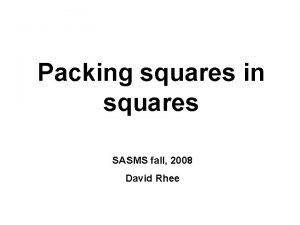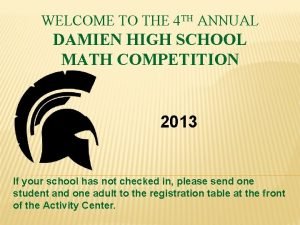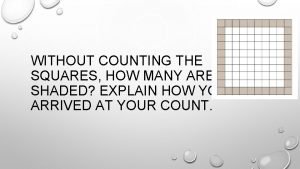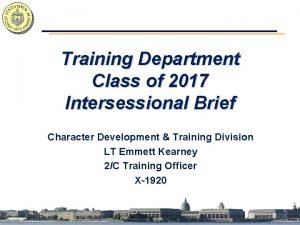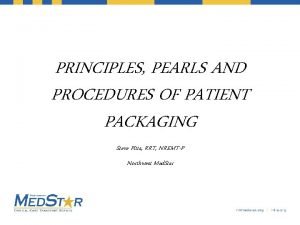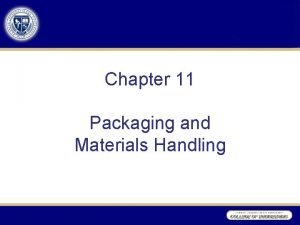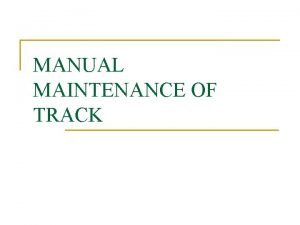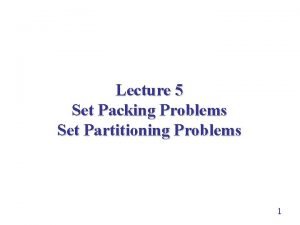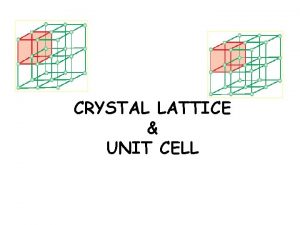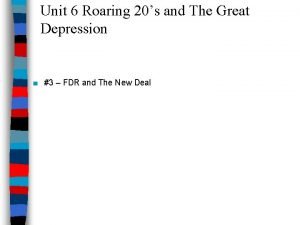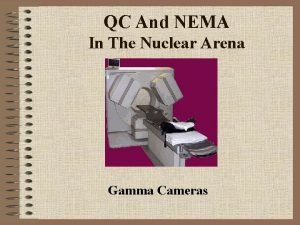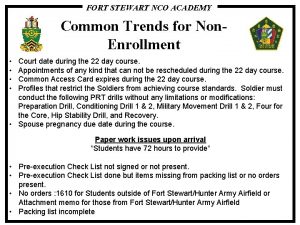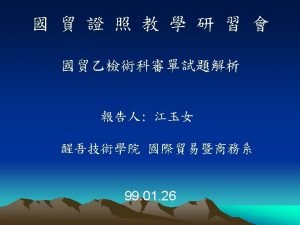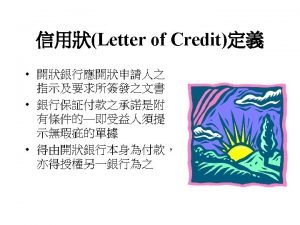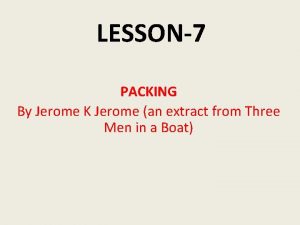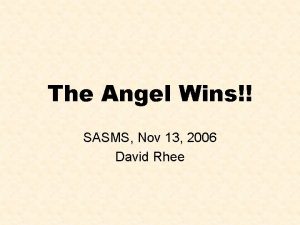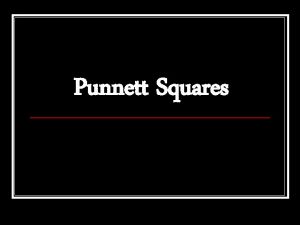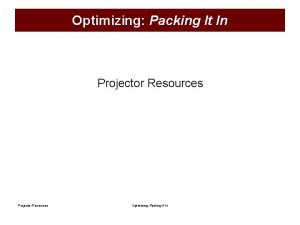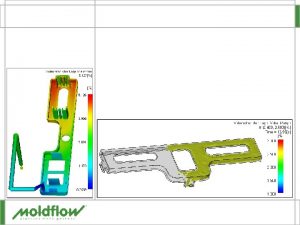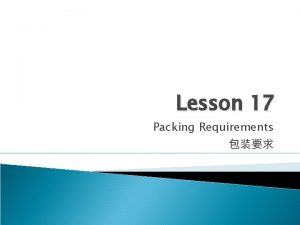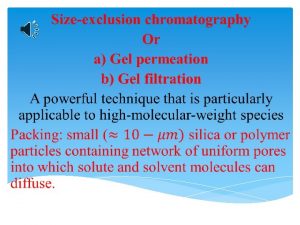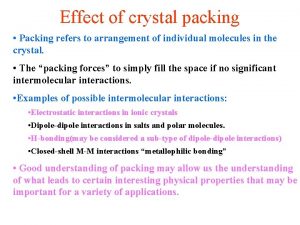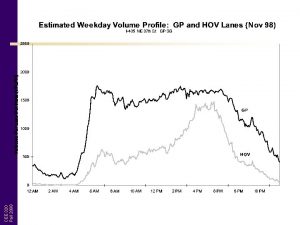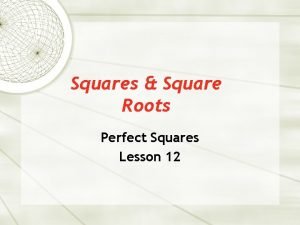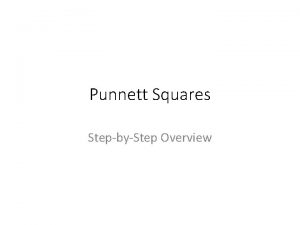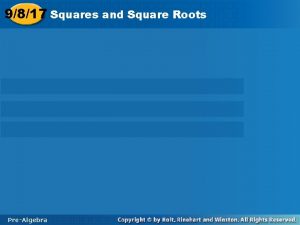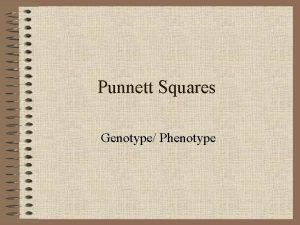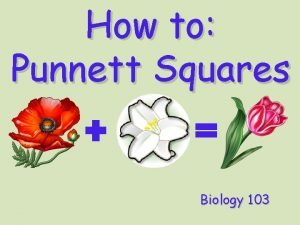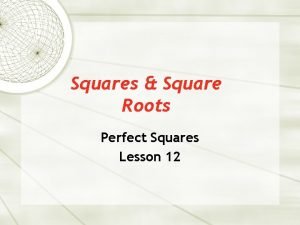Packing squares in squares SASMS fall 2008 David















![3. Lower bounds s(2)=s(3)=2 • (1, 1) is unavoidable in [0, 2]2 by lemma 3. Lower bounds s(2)=s(3)=2 • (1, 1) is unavoidable in [0, 2]2 by lemma](https://slidetodoc.com/presentation_image/db2830ac1baec9667d17753e75bbd7c6/image-16.jpg)








- Slides: 24

Packing squares in squares SASMS fall, 2008 David Rhee

1. Introduction • Packing circles has been studied by Gauss and Kepler since 1600’s • Axel Thue(1890) and Thomas Hales (1998) proved that the hexagonal packing is the densest of all possible sphere packings in 2 D and 3 D • Packing squares began to be studied recently (~1970)

1. Introduction • Let s(n) be the side length of smallest square into which we can pack n unit squares. • s(n) is non-decreasing. • s(n 2)=n. s(17) < 4. 676 • .

2. Upper bounds • Some upper bounds were first considered by Göbel in 1979 s(5)≤ 2+1/√ 2 s(10)≤ 3+1/√ 2 s(27)≤ 5+1/√ 2 s(84)≤ 9+1/√ 2

2. Upper bounds • Other packings using squares tilted by 45° have been found since then. s(10)≤ 3+1/√ 2 s(84)≤ 9+1/√ 2 s(28)≤ 4+1/√ 2 s(27)≤ 5+1/√ 2 s(52)≤ 7+1/√ 2

2. Upper bounds • Some people improved the diagonal packings by slightly moving the squares s(19)≤ 3+4√ 2/3 s(87)<9. 8520

2. Upper bounds • Generally, packings are more complicated. Many of these results were found by a new efficient algorithm found in 2005. s(11)<3. 8771 s(17)<4. 6756 s(29)≤ 5. 9344 s(68)≤ 15/2+√ 7/2 s(71)≤ 8. 9633

2. Upper bounds • s(18)≤(7+√ 7)/2 Hämäläinen (1980) Gustafson (1981) Cantrell (2002) Gensane and Ryckelynck (2004)

2. Upper bounds • It was conjectured that s(n 2 -n)=n. This was disproved by Lars Cleemann. s(172 -17)<17

2. Upper bounds • W(s): =s 2 -max{n: s(n)≤s}, then W(s) is O(s 7/11) (Erdös and Graham, 1975) • W(s)=O(s(3 -√ 3)/2+ε) for every ε>0 (Montgomery, 1978? ) • W(s) is not O(sα) when α<1/2 (Roth and Vaughan, 1978)

3. Lower bounds • Lemma 1. (corner) Any unit square inside the first quadrant whose center is in [0, 1]2 contains the point (1, 1). • Lemma 2. (edge) Let 0<x≤ 1, 0<y≤ 1, and x+2 y<2√ 2. Then any unit square inside the first quadrant whose center is contained in [1, 1+x]x[0, y] contains either the point (1, y) or the point (1+x, y).

3. Lower bounds • Lemma 3. (triangle) If the center of a unit square u is contained in ABC, and each side of the triangle has length no more than 1, then u contains A, B, or C.

3. Lower bounds • Lemma 4. (rectangle) If the center of a unit square u is contained in the rectangle R=[0, 1]x[0, 0. 4], then u contains a vertex of R.

3. Lower bounds • Lemma 5. (trapezoid) If the unit square u has its center in [0, 1]2, u is completely above the xaxis, and u does not contain (0, 1) and (1, 1) then u covers the following: 1) the segment from (0. 2, 1) to (0. 8, 1) 2) some point (0, y) for 1/2≤y≤ 1 and some point (1, y) for 1/2≤y≤ 1. 3) either the point (0, √ 2 -1/2) or the point (1, √ 21/2).

3. Lower bounds To show s(n)≥k: • Find a set of n-1 “unavoidable” points in a square with side length k • Shrink this diagram by a factor of (1 -ε/k) to get a square with side length k-ε • Unit squares must contain one of these n 1 points in the interior, so we can pack at most n-1 squares • Therefore, s(n)>k-ε
![3 Lower bounds s2s32 1 1 is unavoidable in 0 22 by lemma 3. Lower bounds s(2)=s(3)=2 • (1, 1) is unavoidable in [0, 2]2 by lemma](https://slidetodoc.com/presentation_image/db2830ac1baec9667d17753e75bbd7c6/image-16.jpg)
3. Lower bounds s(2)=s(3)=2 • (1, 1) is unavoidable in [0, 2]2 by lemma 1 s(5)=2+1/√ 2 • P={ (1, 1), (1, 1+1/√ 2), (1+1/√ 2, 1+1/√ 2) } is unavoidable in [0, 2+1/√ 2]2 by lemma 1, 2, 3

3. Lower bounds • We can show other lower bounds using the same method s(8)=3 s(15)=4 s(24)=5 s(35)=6

3. Lower bounds • Some lower bound attained by this method are not sharp s(17)≥(40√ 2+19)/17 s(19)≥ 6√ 2 -4

3. Lower bounds s(7)=3 • At least two squares have their centers in the regions containing question marks • There are 2 possible placements of these 2 squares

3. Lower bounds • s(n 2+ n/2 +1) ≥ 2√ 2 + 2(n-2)/√ 5 (Green, 2000) • s(n 2 -2)=s(n 2 -1)=n (Nagamochi, 2005) • Conjecture: If s(n 2 -k)=n, then s((n+1)2 k)=n+1

3. Lower Bounds

4. More problems • Packings of many shapes other than squares are studied

4. More problems • Packing circles into • Rigid packing of general rectangle circles into largest square • Packing cubes into cubes

References • http: //www. stetson. edu/~efriedma/paper s/squares. html - retrived Nov. 8, 2008 • http: //en. wikipedia. org/wiki/Packing_pro blem - retrived Nov. 8, 2008
 Sasms
Sasms 2008 2008
2008 2008 4 squares = 5 9 squares =
4 squares = 5 9 squares = Youcubed squares and more squares answers
Youcubed squares and more squares answers Low packing density
Low packing density Usna summer cruise packing list
Usna summer cruise packing list Closed ecological system
Closed ecological system Plastic packing pearls
Plastic packing pearls International process plants
International process plants Packing learning objectives
Packing learning objectives Through packing
Through packing Set packing problem example
Set packing problem example First fit decreasing bin packing
First fit decreasing bin packing Erroneous cubic cell
Erroneous cubic cell Lin da652q
Lin da652q What was court packing
What was court packing Tetri s
Tetri s Orthogonal hole phantom
Orthogonal hole phantom Fort gordon ncoa
Fort gordon ncoa Darley fire pump parts
Darley fire pump parts These are the services delivered by a valet except
These are the services delivered by a valet except Commercial invoice packing list
Commercial invoice packing list Packing fraction formula
Packing fraction formula Invoice bl
Invoice bl What irritates jerome most?
What irritates jerome most?
